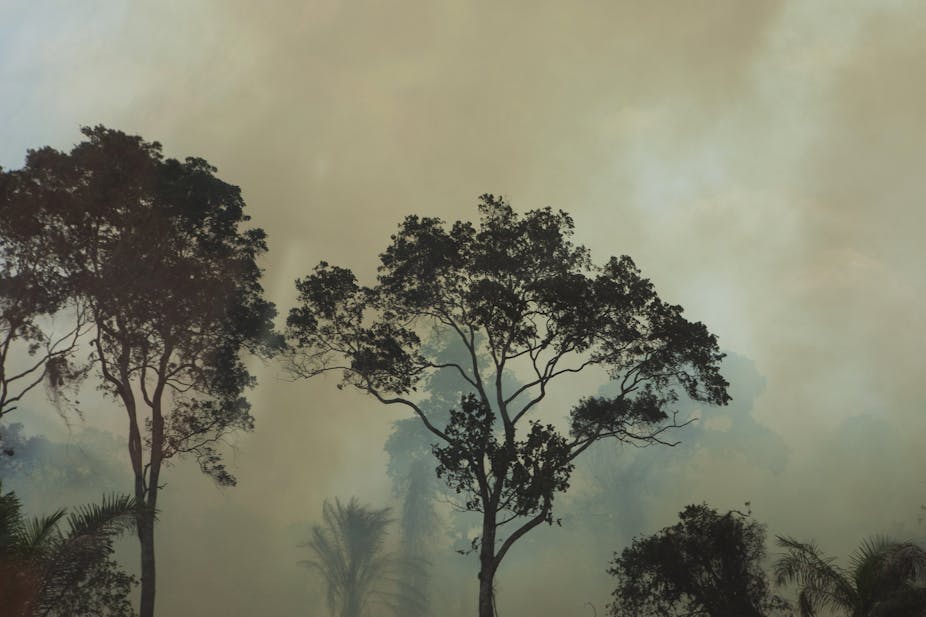Beginning in late October the steady summer rains of the north African savanna abate, and subsistence farmers begin the millennia-old tradition of burning the savanna and open woodland for pastoral land clearing and shifting cultivation.
These fires are very common. Africa’s savanna fires comprise the largest proportion (71%) of areas burned globally and the trees, shrubs and grasses are well adapted to fire.
However, prior to human settlement, the majority of fires occurred during the summer wet season, when natural ignitions from lightning dominated the fire regime. But with the progression of civilisation from nomadic times to one where agriculture is so important, the fire regime and use of fire for crops has changed drastically. Now, most fires occur during the dry season as a direct consequence of agropastoral ignitions.
These fires, which burn continuously from late November through early March, emit massive amounts of microscopic particulates, otherwise known as smoke. Some estimates suggest that emissions of elemental carbon exceed 400 million tonnes annually, 6.7 million of which are emitted as microscopic particulates. Of particular importance are the 375,000 tonnes that are emitted as dark particulates known as black carbon, which efficiently absorbs sunlight and interacts with clouds and climate in numerous ways.
Research shows that smoke has climatic implications which are not innocuous. A recent study of a region in China is one such example. It concludes that suppression of rainfall near the source of industrial smoke emissions caused the non-precipitated moisture to relocate to a nearby mountainous area. This led to dangerous, flooding rains on the mountain slopes. Globally previous research shows that emissions of smoke from fires can disrupt the large-scale Hadley Circulation that delivers rain to the tropics and dry weather to the deserts.
In research recently published, we explore this question in more detail. We used satellite measurements from the Multi-angle Imaging Spectroradiometer and the Moderate Resolution Imaging Spectrometer to determine whether human modification of Africa’s fire regime has unforeseen effects on regional climate.
We found that four-day periods of very low cloud cover coincided with spikes in both fire ignitions and fire emissions. This suggests the existence of a positive feedback loop, whereby fires limit rainfall and reduce cloud cover. This dries and warms the surface and makes it easier for farmers to burn and fires to spread. Over time, the increased burning could extend the dry season.

How smoke influences rainfall
The relationship between smoke and rainfall is complicated. The formation of clouds requires microscopic particulates that provide a solid surface on which atmospheric water vapour can condense. Based on this, it seems that smoke should facilitate cloud formation and rainfall. But the development of rain clouds in this region occurs primarily via convection, which is a meteorological process determined by the vertical mixing of air.
Smoke from fires contains a high percentage of black carbon particulates, one type of aerosol. These aerosols efficiently absorb sunlight much like the Earth’s surface does on a hot afternoon. As the suspended aerosols absorb sunlight, they heat the air and create a warm layer that prevents air from the Earth’s warmed surface from rising above it.
Our research shows that, as a result of the black carbon heating, the upward motion of air necessary to fuel convection diminished and produced a notable suppression of rainfall in the region. Across all of the thousands of data points analysed, daytime convection was less in smoky scenes than in non-polluted scenes. This was even after extensively accounting for meteorological conditions.
The unknowns
The fire-driven reduction in rainfall has immediate implications for the fire regime. Besides the obvious impacts on surface temperature (it would get warmer), precipitation (it would get drier) and climate (it would change the global distribution of rainfall), the reduction in rainfall could also influence the local ignition and spread of fire.
What are the implications of this continent-scale positive feedback loop on global climate warming, and is there any way to preserve the millennia-old burning practices of farmers while still considering the massive effect on climate? These are unanswered questions that we still hope to explore.

